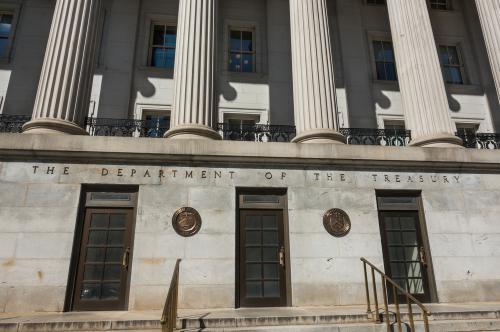Studies in this week’s Hutchins Roundup find the fall in long-term interest rates has less to do with inflation expectations than with real interest rate declines, Black entrepreneurs have less access to capital than white entrepreneurs in a firm’s first eight years, and more.
Want to receive the Hutchins Roundup as an email? Sign up here to get it in your inbox every Thursday.
Falling long-term interest rates reflect real rate declines, rather than inflation expectations or risk
Long-term interest rates have been falling for decades, but it can be difficult to determine whether this trend is driven by nominal factors, like inflation expectations, or real economic forces, such as declining productivity or an aging population. To distinguish between these effects, Jens H. E. Christensen and Glenn D. Rudebusch of the San Francisco Fed and Patrick J. Shultz of UPenn’s Wharton School turn to the market for Canadian government bonds—a relatively stable and risk-free market that hasn’t been artificially altered by large-scale purchases of government bonds by the Canadian central bank. By comparing nominal yields and yields on Real Return Bonds that account for Canadian price inflation, the authors find much of the fall in long-term interest rates is explained by a decline in the real interest rate rather than in inflation expectations or risk premiums. The real rate has fallen by nearly 2.5 percentage points since 2000, while inflation expectations have only declined by about 1 percentage point and inflation risk premiums have fluctuated rather than declining steadily. The authors project that both the real rate and inflation expectations will continue to decline—suggesting that long-term interest rates will remain low for the foreseeable future.
Black entrepreneurs have a harder time accessing capital than their white peers
Using a panel survey of business owners matched with credit scores, Robert W. Fairlie of University of California at Santa Cruz, Alicia Robb of Next Wave Impact and David T. Robinson of Duke find that Black-owned startups have less access to capital than white-owned startups: Black entrepreneurs raise $35,205 in start-up capital on average while white entrepreneurs average $106,720. Moreover, this gap narrows but persists eight years into a firm’s life. The authors find that these racial disparities span a broad range of capital sources but are largest in access to debt (mainly funded by bank loans). Black borrowers are denied loans at higher rates and are more likely than white borrowers to believe their loan applications will be denied, even after controlling for credit scores and founder wealth. The authors also find that regions with higher levels of historical and contemporary inequality have higher levels of unmet capital need and fear of denial among Black entrepreneurs.
Regulatory and supervisory independence improves global financial stability
The independence of banking supervisors and regulators from elected politicians is one of the Basel Committee’s core principles for effective banking supervision, but one to which many countries do not fully adhere. Nicolo Fraccaroli of Brown and Rhiannon Sowerbutts and Andrew Whitworth of the Bank of England argue that this lack of independence may undermine international financial stability. Using a new index of regulatory and supervisory independence, the authors find that an increase in independence is associated with a 2.8% reduction in non-performing loans (an indicator of banking sector risk) and a 1.2 percentage point decrease in banks’ cost-to-income ratio (an indicator of banking efficiency), while having no effect on bank profitability. However, greater independence is also associated with a 0.18% decrease in bank lending. Insulating regulators and supervisors from political pressures to let credit to grow unchecked or allow lending practices that favor political connections, for example, benefits long-term financial stability without sacrificing bank performance, the authors conclude.
Chart of the week: S&P 500 Hits Record High
Chart courtesy of the New York Times
Quote of the week:
“The main risk [of crypto-assets] lies in relying purely on technology and the flawed concept of there being no identifiable issuer or claim. This also means that users cannot rely on crypto-assets maintaining a stable value: they are highly volatile, illiquid and speculative, and so do not fulfil all the functions of money. Recently, we have seen the emergence of stablecoins, which try to solve crypto-assets’ problem of a lack of stability and trust by pegging their assets to stable and trusted fiat money issued by States. And the issuers of “global” stablecoins, which target a global footprint, further aim to introduce their own payment schemes and clearing and settlement arrangements. Although stablecoins could drive additional innovation in payments and be well integrated into social media, trade and other platforms, they pose serious risks,” says Christine Lagarde, President of the European Central Bank.
“If widely adopted, they could threaten financial stability and monetary sovereignty. For instance, if the issuer cannot guarantee a fixed value or if they are perceived as being incapable of absorbing losses, a run could occur. Additionally, using stablecoins as a store of value could trigger a large shift of bank deposits to stablecoins, which may have an impact on banks’ operations and the transmission of monetary policy. Stablecoins, particularly those backed by global technology firms (the “big techs”), could also present risks to competitiveness and technological autonomy in Europe, as they would attempt to leverage their competitive advantage and control of large platforms. Their dominant positions may harm competition and consumer choice, and raise concerns over data privacy and the misuse of personal information.”
The Brookings Institution is committed to quality, independence, and impact.
We are supported by a diverse array of funders. In line with our values and policies, each Brookings publication represents the sole views of its author(s).











Commentary
Hutchins Roundup: Inflation expectations, Black entrepreneurs’ access to capital, and more
December 3, 2020